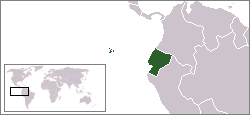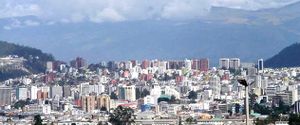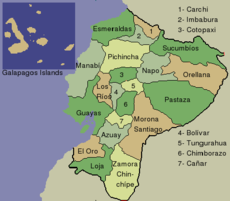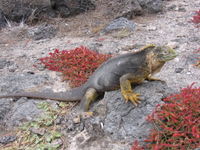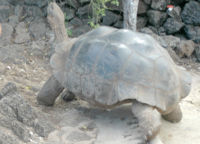Ecuador
2007 Schools Wikipedia Selection. Related subjects: Central & South American Countries; Countries
| República del Ecuador Republic of Ecuador |
|||||
|
|||||
| Motto: Spanish: "Dios, patria y libertad" (English: "God, homeland and liberty") |
|||||
| Anthem: Salve, Oh Patria | |||||
| Capital | Quito |
||||
|---|---|---|---|---|---|
| Largest city | Guayaquil | ||||
| Official languages | Spanish1 | ||||
| Government | Republic | ||||
| - President | Alfredo Palacio | ||||
| - Vice-President | Alejandro Serrano | ||||
| Independence | |||||
| - From Spain | May 24, 1822 | ||||
| - From Gran Colombia | May 13, 1830 | ||||
| Area | |||||
| - Total | 256,370 km² ( 72nd) 98,985 sq mi |
||||
| - Water (%) | 8.8 | ||||
| Population | |||||
| - July 2005 estimate | 13,228,000 ( 67th) | ||||
| - Density | 47/km² ( 147th) 122/sq mi |
||||
| GDP ( PPP) | 2005 estimate | ||||
| - Total | $57.04 billion ( 70th) | ||||
| - Per capita | $4,316 ( 113th) | ||||
| HDI (2003) | 0.759 (medium) ( 82nd) | ||||
| Currency | U.S. dollar2 ( USD) |
||||
| Time zone | ( UTC-5; UTC -6 (Galápagos Islands)) | ||||
| Internet TLD | .ec | ||||
| Calling code | +593 | ||||
| 1 Quichua and other Amerindian languages spoken by indigenous communities. 2 Sucre until 2000. |
|||||
Ecuador, officially the Republic of Ecuador (Spanish: República del Ecuador, short form Ecuador, IPA [re'puβlika ðel ekwa'ðoɾ]) is a representative democratic republic in South America, bounded by Colombia on the north, by Peru on the east and south, and by the Pacific Ocean on the west. The country also includes the Galápagos Islands (Archipiélago de Colón) in the Pacific, about 965 kilometers (600 miles) west of the mainland. Ecuador is the Spanish word for equator. Ecuador straddles the equator and has an area of 256,370 square kilometers (98,985 mi²). Its capital city is Quito.
History
Advanced indigenous peoples flourished in Ecuador long before the area was mostly conquered by the Inca empire in the 15th century. Through a succession of wars and marriages with the different nations that inhabited the Interandean valley, the region became part of the Inca Empire. Atahualpa, one of the sons of the Inca emperor Huayna Capac, was born in Quito. However, he could not receive the crown of the Empire since the emperor had another son, Huascar, born in Cusco, the capital of the Inca Empire. Therefore the empire was divided in two: Atahualpa received the north, with his capital in Quito, and Huascar received the south with its capital in Cuzco. In 1531, the Spanish conquistadors, under Francisco Pizarro, arrived in an Inca empire torn by civil war. Atahualpa wanted to align with the Spanish to defeat Huascar and reign over a re-unified Incan empire. The Spanish, however, had conquest intentions and established themselves in a fort in Cajamarca, captured Atahualpa during the Battle of Cajamarca and held him for ransom. A room was filled with gold to secure his release. During his capture, Atahualpa arranged for the murder of his half-brother Huascar in Cuzco. The stage was set for the Spaniards to take over the Incan empire. Despite being surrounded and vastly outnumbered, the Spanish executed Atahualpa. To escape the confines of the fort, the Spaniards fired all their cannons and broke through the lines of the bewildered Incans. In subsequent years the Spanish colonists became the new elite centering their power in Peru.
The indigenous population was decimated by disease in the first decades of Spanish rule — a time when the natives also were forced into the " encomienda" labor system for Spanish landlords. In 1563, Quito became the seat of a royal "audiencia" (administrative district) of Spain and part of the Peruvian Viceroyalty with its capital in Lima.
After nearly 300 years of Spanish colonization, Quito was a city of about 10,000 inhabitants, and it was there in 1822 that Ecuador joined Simón Bolívar's Republic of Gran Colombia, only to become a separate republic in 1830.
The 19th century was marked by instability, with a rapid succession of rulers. The conservative Gabriel Garcia Moreno unified the country in the 1860s with the support of the Roman Catholic Church. In the late 1800s, world demand for cocoa tied the economy to commodity exports and led to migrations from the highlands to the agricultural frontier on the coast.
A coastal-based liberal revolution in 1895 under Eloy Alfaro reduced the power of the clergy, and this liberal wing retained power until the military coup of 1925. The 1930s and 1940s were marked by populist politicians such as five-time President José María Velasco Ibarra.
Control over territory in the Amazon has led to a long-lasting dispute between Ecuador and Peru. In 1941, in midst of fast-growing tensions between the two countries, war broke out. Peru claimed that Ecuador's military presence in Peruvian-claimed territory was an invasion while Ecuador, on the other hand, claimed Peru invaded Ecuador. In July 1941 troops were mobilized. Peru had an army of 11,681 troops, facing a poorly supplied and badly armed Ecuadorian force of 5,300 soldiers, of which a little over 1,300 were deployed in the southern provinces of the country. Hostilities broke on July 5, 1941, when Peruvian forces crossed the Zarumilla river on several spots, testing the strength and disposition of the Ecuadorian border troops. Finally, on July 23, 1941, the Peruvians launched a major invasion, crossing the Zarumilla river in force and advancing into the Ecuadorian province of El Oro. Over the course of the war Peru gained control over all the disputed territory and occupied the Ecuadorian province of El Oro and some parts of the province of Loja (some 6% of the country), demanding that the Ecuadorian government give up their territorial claims. The Peruvian Navy blocked the port of Guayaquil, cutting supplies to the Ecuadorian troops. After a few weeks of war and under pressure by the U.S and several Latin American nations, all fighting came to a stop. Ecuador and Peru came to an accord formalised in the Rio Protocol, signed on January 29, 1942, in favour of hemispheric unity against the Axis Powers in World War II. As a result of its victory, Peru was awarded the disputed territory. Two more wars would follow to finally end the dispute. See Paquisha Incident and Cenepa War
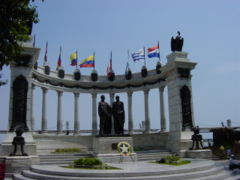
Recession and popular unrest led to a return to populist politics and domestic military interventions in the 1960s, while foreign companies developed oil resources in the Ecuadorian Amazon. In 1972, the construction of the Andian pipeline, which brought oil from the east to the coast was completed, making Ecuador South America's second largest oil producer. That same year a nationalist military junta overthrew the government, remaining in power until 1979 when more democratic constitutional measures were implemented. By 1982, the government faced an economic crisis, characterized by high inflation, budget deficits, a falling currency, mounting debt service, and uncompetitive industries, leading to chronic government instability.
Many years of mismanagement, starting with the mishandling of the country's debt during the 1970s military regime, have left the country essentially ungovernable. By the mid 90s, the government of Ecuador has been characterized by a weak executive branch that struggles to appease the ruling classes, represented in the legislative and judiciary. The last three democratically elected presidents have failed to finish their terms during that period.
Among the most relevant factors in the democratic instability is the emergence of the indigenous population as an active constituency. The population were motivated by government failures to deliver on promises of land reform and lower unemployment, and by historical exploitation by the land-holding elite.
Their movement, along with the continuing destabilizing efforts by both the Elite and Leftist movements, have led to a deterioration of the executive office. The public and the other branches of government give the president very little political capital to work with, as happened when in April 2005 Ecuador's Congress ousted President Lucio Gutiérrez. The Vice-President, Alfredo Palacio, took his place and remained in office until the presidential election of 15 October 2006, which did not produce a conclusive winner. The two highest polling candidates on that occasion, Alvaro Noboa and Rafael Correa went on a runoff election on 26 November, which results showed Correa winning the election with 56.8% of the vote.
Politics
Politics of Ecuador takes place in a framework of a presidential representative democratic republic, whereby the President of Ecuador is both head of state and head of government, and of a pluriform multi-party system. Executive power is exercised by the government. Legislative power is vested in both the government and the Congress. The Judiciary is independent of the executive and the legislature.
Executive Branch: President: Alfredo Palacio (since 20 April 2005 and after Lucio Guitiérrez was removed from office by Congress) Vice President: Nicanor Alejandro Serrano Aguilar (since 5 May 2005)
Cabinet: Cabinet is appointed by the president who has sole authority for determining the number of Ministers and their scope. Currently there are 15 Ministers (Ministerios) and 7 Secretariats (Secretarías).
Elections: the President and Vice president are elected on the same ticket by universal, mandatory popular vote for a four-year term and are not allowed to serve consecutive terms. Last general election was held on October 20th 2002 with a run-off election that took place on November 24th 2002 in which Lucio Guitiérrez was elected as President. Next general elections will take place in October 2006.
Legislative Branch: unicameral National Congress Congreso Nacional that has 100 seats with members that are popularly elected by province to serve four-year terms.
Judicial Branch: Represented by the Supreme Court Corte Suprema. According to the country's constitution, Justices Ministros Juez are elected by the existing members of the Supreme Court, nonetheless in December 2004 Congress successfully replaced the entire court.
Source: CIA worldfactbook
Foreign relations
Ecuador has often placed great emphasis on multilateral approaches to international issues. Ecuador is a member of the United Nations (and most of its specialized agencies) and also is a member of many regional groups, including the Rio Group, the Latin American Economic System, the Latin American Energy Organization, the Latin American Integration Association, and The Andean Pact. Ecuador holds close relations with the US. In 2006, a contract breach from Occidental, a North American oil company, created stress in the USA-Ecuador relations. The Ecuadorian government declared the contract with the oil giant invalid, being the main cause for the delay in the Free Trade Agreement negotiation talks between the two countries. The Atpdea treaty will soon expire, meaning that commerce with the US will be significantly reduced, pressuring Ecuador to look for other international markets.
The outlook for the flower industry, in particular, is grim. The US buys 75% of all of Ecuador's flower exports. Ecuador's foreign policy failure is estimated to cost the country 30,000 jobs per year.
Geography
Ecuador has three main geographic regions, plus an insular region in the Pacific Ocean.
- La Costa, or the coast, comprises the low-lying littoral in the western part of the country, including the Pacific coastline.
- La Sierra ("the saw") is the high-altitude belt running north to south along the centre of the country, its mountainous terrain dominated by the Andes mountain range.
- El Oriente ("the east") comprises the Amazon rainforest areas in the eastern part of the country, accounting for just under half of the country's total surface area, though populated by under 5% of the population.
- Finally, the Región Insular is the region comprising the Galápagos Islands, some 1,000 kilometers (620 mi) west of the mainland in the Pacific Ocean.
Ecuador's capital is Quito, and is located in the province of Pichincha in the Sierra region. Its largest city is Guayaquil, located in the province of Guayas in the Costa. Cotopaxi, which is located just south of Quito, in the neighbouring province of that same name, is often wrongly claimed to be the world's highest active volcano, but several peaks in northern Chile and southern Peru are higher and (at least currently) more active.
Administrative divisions
Ecuador is divided into 22 provinces, each with its own administrative capital. The capitals are provided in parentheses.
|
|
Economy
Ecuador has substantial petroleum resources and rich agricultural areas. Because the country exports primary products such as oil, bananas, and shrimp, fluctuations in world market prices can have a substantial domestic impact. Industry is largely oriented to servicing the domestic market. Deteriorating economic performance in 1997-98 culminated in a severe economic and financial crisis in 1999. The crisis was precipitated by a number of external shocks, including the El Niño weather phenomenon in 1997, a sharp drop in global oil prices in 1997-98, and international emerging market instability in 1997-98. These factors highlighted the Government of Ecuador's unsustainable economic policy mix of large fiscal deficits and expansionary money policy and resulted in an 7.3% contraction of GDP, annual year-on-year inflation of 52.2% and a 65% devaluation of the national currency in 1999, which helped precipitate an unprecedented default on external loans later that year.
On January 9, 2000, the administration of President Jamil Mahuad announced its intention to adopt the U.S. dollar as the official currency of Ecuador to address the ongoing economic crisis. The adoption of the U.S. dollar as currency, as opposed to pegging a local currency to it, means that the benefits of seigniorage accrue to the U.S. economy whether or not there is any compensation for this. Subsequent protest led to the removal of Mahuad from office and the elevation of Vice President Gustavo Noboa to the presidency.
The Noboa government confirmed its commitment to dollarize as the centerpiece of its economic recovery strategy. The government also entered into negotiations with the International Monetary Fund (IMF), culminating in the negotiation of a 12-month stand-by arrangement with the Fund. Additional policy initiatives include efforts to reduce the government's fiscal deficit, implement structural reforms to strengthen the banking system and regain access to private capital markets. Buoyed by high oil prices, the Ecuadorian economy experienced a modest recovery in 2000, with GDP rising 1.9%. However, 70% of the population lives below the poverty line, more than double the rate of 5 years ago. Inflation in 2000 remained high at 96.1%, but the rate of inflation continues to fall. Monthly inflation in February 2001 was 2.9%.
Demographics
Ecuador's population is ethnically diverse. The largest ethnic group is comprised of Mestizos, the mixed descendants of Spanish colonists and indigenous Amerindians, who constitute just over 65% of the population. Amerindians are second in numbers and account for approximately a quarter of the current population, around 25%. Whites are mainly criollos, the relatively unmixed descendants of early Spanish colonists, and account for some 15%. The small Afro-Ecuadorian minority — including Mulattos and zambos, and largely based in Esmeraldas and Ibarra — and immigrants from around the world constitute the remainder. Many foreign nationals have set up residence in Ecuador. There are sizeable expatriate Ecuadorian communities in Spain, Italy and the U.S.A.
The tropical forest region to the east of the mountains remains sparsely populated and contains only about 3% of the population.
Although the constitution demands that 30% of gross revenue be dedicated to education, the government’s stated goal is to dedicate 11% of the budget. It is estimated that gross domestic product (GDP) spending will reach 4% in 2003. The UN Children's Fund ( UNICEF) places adult literacy at 90%, but notes that this rate has been stagnant for more than ten years. The UN Educational, Scientific, and Cultural Organization (UNESCO) reports that only 87% of the primary school teachers and 72% of high school teachers have received training. The public education system is tuition-free, and attendance is mandatory from ages five to fourteen. However, the Ministry of Education reports that only 10% of five year olds actually have access to daily education and that only 66% of youngsters finish six years of schooling. In rural areas, only 10% of the youngsters go on to high school. Ministry statistics give the mean number of years completed as 6.7. Ecuador has sixty one universities, many of which now offer graduate degrees, although only 18% of the faculty in public universities possess graduate degrees. 300 Higher Institutes offer two to three years of post-secondary vocational or technical training. The Higher Education Reform Act transferred oversight of these poorly regulated institutes from the Ministry of Education to the CONESUP.
Religion

Approximately 96.8% of Ecuadorians are Roman Catholic. Much of the population is practicing and attends Mass regularly. In the rural parts of Ecuador, indigenous beliefs and Christianity are sometimes syncretized.
There is a small Muslim minority numbering in the low thousands. The Jewish community numbers just over 1,000 individuals and is mostly of German and Italian origin.
There are also Sephardic Jews (Judeo-Spanish Jews). Few of them still practice Judaism at different levels, while the majority are today Christians whose ancestors were converted to Catholicism.
Culture
Ecuador's mainstream culture is defined by Ecuador's mestizo majority and, like their ancestry, is a mixture of European and Amerindian influences infused with African elements inherited from slave ancestors. Ecuador's indigenous communities are integrated into that mainstream culture to varying degrees, but some may also practice their own autochthonous cultures, particularly the more remote indigenous communities of the Amazon basin. African-Ecuadoreans, much less integrated into the mainstream majority, are victims of high-unemployment and racism.
Sport
The most popular sport in Ecuador, as in most South American countries, is futbol (soccer). Some of its best known professional teams include Barcelona S.C. and C.S. Emelec, from Guayaquil, Liga Deportiva Universitaria de Quito and El Nacional (the Ecuadorian Armed Forces team) from Quito, Olmedo from Riobamba, and Deportivo Cuenca, from Cuenca. The matches of the Ecuadorian national football team are the most watched sports events in the country. Ecuador has qualified for the final rounds of both the 2002 and 2006 FIFA World Cups. Ecuador beat Poland and Costa Rica to finish 2nd to Germany in Group A in the 2006 World Cup and qualify for the second round for the first time in their history, where they lost 1-0 to England. Futsal is particularly popular for mass participation.
There is considerable interest in tennis in the middle and upper classes in the Ecuadorian society, and several Ecuadorian professional players have attained considerable international fame, including Francisco Segura, Andrés Gómez and, in the 1990s, Nicolas Lapentti. Basketball also has a high profile, while Ecuador's specialities include Ecuavolley, a 3 person variation of volleyball. Bullfighting is practiced at a professional level only in Quito, during the annual festivities which commemorate the Spanish founding of the city, although bloodless variations of this sport, called rodeos montubios are practiced in many rural areas during local festivities.
Olympic sports are also popular especially since Ecuador obtained its first Olympic gold medal in Atlanta's 1996 Olympic Games, through Jefferson Pérez, on the 20km walk. There is flourishing activity in non-traditional sports such as mountainbiking, motorbiking, surfing, paintball (Equadorian sides are among the top 6 ranked in the continent ) and mountain climbing among others.
Food
The food in Ecuador is very diverse, varying with altitude as do the agricultural conditions. Pork, chicken, meat or “cuy” ( guinea pig) are popular in the mountain regions served with an immense variety of cereals and potatoes or rice. A street food in mountain regions of Ecuador is potatoes served with roasted pig. Fanesca is also a dish that has been made famous in Ecuador, it is a soup made during the time of Lent and is made with numerous types of bean (i.e. green beans, lima beans, chochos) and milk and is usually served with fish.
There is a great variety of fresh fruit available, particularly at lower altitudes. Seafood is popular at the coast, particularly with prawns. Shrimp is very popular and is very fresh in Ecuador. Plantain and peanut based dishes and foods are the basis of most coastal meals, which in general are served in two courses: a "caldo", or soup, which may be "aguado" (a thin soup, usually with meat), or "caldo de leche", a cream vegetable soup. The second course might typically include rice, some meat or fish in a "menestra" (stew), and salad or vegetables. Patacones are popular sidedishes with most coastal meals.
Some of the typical dishes in the coastal region are: ceviche, pan de almidón, corviche, guatita, encebollado and empanadas; in the mountain region: hornado, fritada, humitas, tamales, llapingachos, etc.
Art
See Ecuadorian painters
Film
The 2005 film Crónicas, written and directed by Ecuadorian Sebastián Cordero starring John Leguizamo in his Spanish-language debut, is set and filmed entirely in Ecuador.
The 2004 film Maria Full of Grace was partially shot in Ecuador, although it is set in Colombia.
The 2003 film "The Dancer Upstairs" was filmed in Ecuador, it was directed by John Malkovich and it starred Javier Bardem.
Beyond the Gates of Splendor (2002) directed by Jim Hanon is a documentary about five missionaries killed by the Huaorani Indians in the 1950s. This film was Hanon's first film release based on a true story. He recycles the story into the 2006 Hollywood production The End of the Spear planning to be promoted by Christian groups. Most of this film was shot in Panama.
The film Proof of Life (2000), starring Meg Ryan and Russell Crowe, was filmed in Ecuador. The film, nonetheless, takes place in a fictitious South American country named 'Tecala'. The guerrilla movement depicted in the film is reminiscent of Peru's Shining Path or Colombia's FARC.
Ratas, Ratones, Rateros (1999) written and directed by Ecuadorian Sebastián Cordero is an Ecuadorian film about an 18 year quiteño whose cousin, a thief from the more violent coastal city of Guayaquil, embroils all those around him. The film has been accused by several critics of painting an extremely distorted contrast between the coast (Guayaquil) and the highlands (Quito), which stems from the ever-present feelings of regionalism between the aforementioned parties.
Entre Marx y una Mujer Desnuda (1995), known by the title Between Marx and a Nude Woman, is difficult to find, but this film created by Ecuadorian Camilo Luzuriaga provides a window into the life of young Ecuadorian leftists living in a country plagued by the remnants of feudal systems and coup d'etats.
The 1991 film "Sensaciones" was directed by ecuadorean sieblings Juan Esteban Cordero and Viviena Cordero, and shot in Ecuador. Viviana Cordero was then involved in the production of "Ratas, Ratones, y Rateros" (1999) and later produced "Un Titán en el Ring" (2002).
The 1980s film Vibes, starring Cyndi Lauper and Jeff Goldblum, was shot in Ecuador. The Andean cities served as a backdrop for the film.
In addition to film, the science fiction novel by Rod Glenn, The King of America, features locations in Ecuador.
Transportation
Ecuador has a network of national highways maintained by the Ministerio de Obras Públicas y Comunicaciones (Ministry of Public Works and Communication) government agency . The Pan-American Highway connects the northern and southern portions of the country as well as connecting Ecuador with Colombia to the north and Peru to the south. The quality of roads, even on trunk routes, is highly variable.


